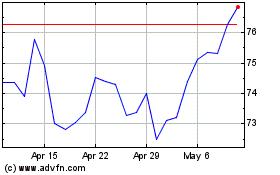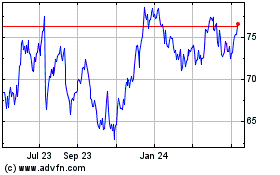By Asjylyn Loder
For State Street Corp., the company that pioneered the $5
trillion exchange-traded fund industry, it's been a long way
down.
Last week, the Boston firm reported that investors took out as
much cash as they put into its $639 billion ETF business this
spring. It was the worst showing among the three largest issuers
and sent State Street's share of the U.S. ETF industry to an
all-time low.
State Street launched the first ETF 25 years ago and dominated
the market for a decade. Today, its slice of U.S. ETF assets is
just 17.3% -- down from 49% 15 years ago. More worrying for its
future, State Street captured just 5.9% of the $343 billion that
poured into ETFs in the past year. By contrast, Vanguard Group and
BlackRock Inc.'s iShares took in a combined 67%. Even Charles
Schwab Corp., a relative newcomer with just 22 ETFs, had a fatter
haul.
How State Street squandered its first-mover advantage for one of
the most popular financial products ever created shows that being
first can sometimes be as much of a hindrance as a head-start.
It's easy to point out State Street's missteps in hindsight, but
no one knew then how big the ETF industry was going to be, said Jim
Ross, chairman of State Street's global SPDR business. "If you go
back 25 years, you can think of some things you might do
differently," he said.
To be sure, State Street is still the third-largest ETF issuer,
but it has been hamstrung by a product suite that's vulnerable to
market whims. It has struggled to connect with mom-and-pop
investors. Some of its most popular funds are burdened by
decades-old agreements that make State Street's funds more
expensive than the competition's, a disadvantage in an industry
where the cheapest funds win the most assets.
State Street doesn't even own the brand name of its ETF
franchise, and instead pays hefty fees to rent it from index
provider S&P Global Inc.
Nowhere are State Street's problems more apparent than in its
flagship fund. The SPDR S&P 500 ETF Trust, best known by its
ticker SPY, has swelled into a $269 billion behemoth and is one of
the most-traded securities on the planet. But it has seen $4.2
billion in investor withdrawals in the past year while nearly
identical products from BlackRock and Vanguard -- which cost half
as much -- gained a combined $26.3 billion.
Named after Standard & Poor's Depositary Receipts, shortened
to SPDR (pronounced "spider"), SPY was the first to package every
company in the S&P 500 index into a single share that, unlike a
mutual fund, could be bought and sold on the stock exchange. The
now-defunct American Stock Exchange celebrated SPY's January 1993
debut by hanging a 9-foot inflatable spider over the trading floor
and giving out hundreds of plastic spider rings.
SPY was a far bigger hit than its inventors had predicted, and
State Street followed with new ETFs pegged to other stock indexes,
including the popular sector ETFs that invested in industries like
energy and technology.
But there were early signs of trouble. The staid Boston
institution has long treated its ETF business as an afterthought
compared with its far larger businesses in trust banking and asset
management for major institutional investors.
Earlier in July, State Street's share price plummeted after the
firm announced it was buying a financial-data firm and canceling
planned share buybacks. In the earnings call that followed, ETFs
were barely mentioned.
"The ETFs were a small part of a big bank that didn't get this
business, " said John Jacobs, a former Nasdaq executive who
launched the popular Nasdaq 100 ETF in 1999. "They were really,
really conflicted about how much to put into the business and how
much to go after it."
When a quirky San Francisco offshoot of Barclays PLC rolled out
dozens of new iShares ETFs in mid-2000, State Street was slow to
perceive the threat. In the years that followed, the upstart hired
a massive sales force, sponsored a Tour de France team (later
dropped amid doping allegations) and backed a catamaran racing
series that traveled the world, iShares emblazoned on the
sails.
IShares unseated State Street as the world's largest ETF issuer
in early 2004 and widened its lead in the years that followed.
Vanguard, too, pushed into the market, and its low-cost funds
quickly began gobbling up market share.
State Street was caught flat-footed. Its ETFs were sold under
multiple brand names. The ideas for its biggest successes, notably
SPY and the sector ETFs, had come from outside the firm. In fact,
State Street nearly declined the World Gold Council's idea for a
bullion-backed ETF. The fund, better known by its ticker GLD, is
now one of State Street's most lucrative.
To amp up its brand recognition, State Street consolidated all
of its ETFs under the SPDR name in 2007, but there was a downside:
The SPDR trademark belongs to S&P. When it expanded its use of
the name, State Street also extended until 2031 a contract under
which S&P gets one-third of the fees paid by SPY's investors.
S&P's cut alone -- $3 a year for every $10,000 invested -- is
almost as much as the entire fee BlackRock and Vanguard charge for
their comparable funds.
Between SPY and other fee-sharing arrangements, State Street
paid almost $143 million to S&P last year, more than triple the
licensing, data and other fees paid by Vanguard and almost double
those of BlackRock, which bought iShares from Barclays in 2009.
Those legacy contracts make it difficult for State Street to
match aggressive price cuts from BlackRock and Vanguard, especially
after BlackRock launched an ultra-low-cost ETF lineup in 2012.
Compounding the problems, the fallout from the financial crisis
left State Street financially hobbled. In 2011, activist investors
urged the firm to sell off the investment-management division.
Market share kept falling, along with morale in its ETF
business.
The firm hired a consultant to figure out where it had gone
wrong. Some of the client feedback was scathing. Customers called
State Street "amateurish" and "plain vanilla" compared to the
"rocket scientists" at the competition, according to a copy of the
2013 report reviewed by The Wall Street Journal.
Executives summoned dozens of managers to a two-day meeting at
Babson College in October 2013, a few miles from its Boston
headquarters. The message: State Street needed a comeback. But some
of State Street's ETF veterans grumbled that the firm had paid
consultants to repeat what they'd been telling their bosses for
years.
Following the report, State Street recruited several new
executives, among them iShares alum Rory Tobin, who is now head of
the SPDR ETF business.
Shortly after he arrived, Vanguard overtook State Street as the
second-largest ETF issuer, and State Street's market share
continued to fall as investors flocked to the cheaper ETFs offered
by BlackRock and Vanguard.
"When I started here in December 2014, I was struck by the way
it was organized -- or maybe the degree to which it was not
organized -- the way iShares was," Mr. Tobin said.
State Street has since restructured its fragmented ETF business,
an ongoing process that included an overhaul of its sales force
last year, Mr. Tobin said.
One of the biggest changes was State Street's introduction of
its own low-cost lineup last October, a move that industry analysts
viewed as long overdue. The funds have since attracted more than
$16 billion in new investor cash. But just as it took years for
State Street to squander its lead, it will also take years to
regain its former dominance, if it can.
"It's step by step," Mr. Tobin said. "I'm not going to say
there's a silver-bullet answer that gets us back up to significant
market share."
Write to Asjylyn Loder at asjylyn.loder@wsj.com
(END) Dow Jones Newswires
July 27, 2018 05:44 ET (09:44 GMT)
Copyright (c) 2018 Dow Jones & Company, Inc.
State Street (NYSE:STT)
Historical Stock Chart
From Jun 2024 to Jul 2024

State Street (NYSE:STT)
Historical Stock Chart
From Jul 2023 to Jul 2024
